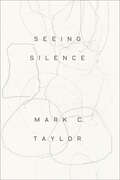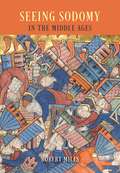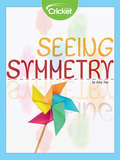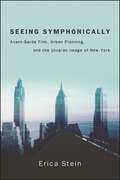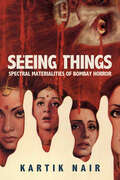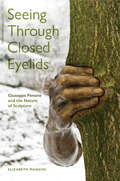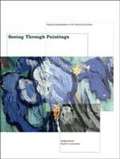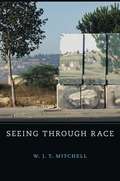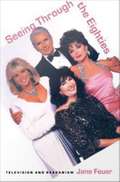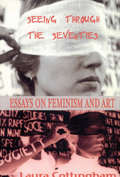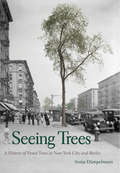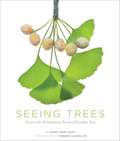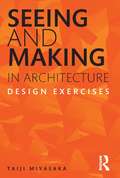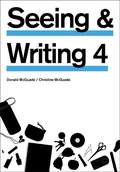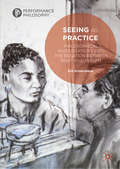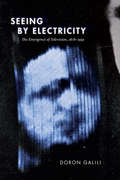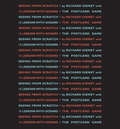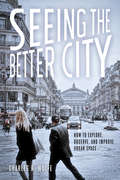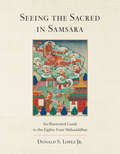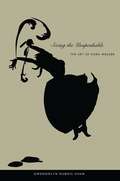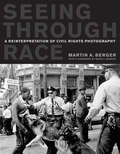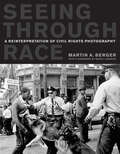- Table View
- List View
Seeing Silence
by Mark C. Taylor“To hear silence is to find stillness in the midst of the restlessness that makes creative life possible and the inescapability of death acceptable.” So writes Mark C. Taylor in his latest book, a philosophy of silence for our nervous, chattering age. How do we find silence—and more importantly, how do we understand it—amid the incessant buzz of the networks that enmesh us? Have we forgotten how to listen to each other, to recognize the virtues of modesty and reticence, and to appreciate the resonance of silence? Are we less prepared than ever for the ultimate silence that awaits us all? Taylor wants us to pause long enough to hear what is not said and to attend to what remains unsayable. In his account, our way to hearing silence is, paradoxically, to see it. He explores the many variations of silence by considering the work of leading modern and postmodern visual artists, including Barnett Newman, Ad Reinhardt, James Turrell, and Anish Kapoor. Developing the insights of philosophers, theologians, writers, and composers, Taylor weaves a rich narrative modeled on the Stations of the Cross. His chapter titles suggest our positions toward silence: Without. Before. From. Beyond. Against. Within. Between. Toward. Around. With. In. Recasting Hegel’s phenomenology of spirit and Kierkegaard’s stages on life’s way, Taylor translates the traditional Via Dolorosa into a Nietzschean Via Jubilosa that affirms light in the midst of darkness. Seeing Silence is a thoughtful meditation that invites readers to linger long enough to see silence, and, in this way, perhaps to hear once again the wordless Word that once was named “God.”
Seeing Sodomy in the Middle Ages
by Robert MillsDuring the Middle Ages in Europe, some sexual and gendered behaviors were labeled "sodomitical” or evoked the use of ambiguous phrases such as the "unmentionable vice” or the "sin against nature. ” How, though, did these categories enter the field of vision? How do you know a sodomite when you see one? In Seeing Sodomy in the Middle Ages, Robert Mills explores the relationship between sodomy and motifs of vision and visibility in medieval culture, on the one hand, and those categories we today call gender and sexuality, on the other. Challenging the view that ideas about sexual and gender dissidence were too confused to congeal into a coherent form in the Middle Ages, Mills demonstrates that sodomy had a rich, multimedia presence in the period--and that a flexible approach to questions of terminology sheds new light on the many forms this presence took. Among the topics that Mills covers are depictions of the practices of sodomites in illuminated Bibles; motifs of gender transformation and sex change as envisioned by medieval artists and commentators on Ovid; sexual relations in religious houses and other enclosed spaces; and the applicability of modern categories such as "transgender,” "butch” and "femme,” or "sexual orientation” to medieval culture. Taking in a multitude of images, texts, and methodologies, this book will be of interest to all scholars, regardless of discipline, who engage with gender and sexuality in their work.
Seeing Symmetry
by Amy TaoJoin us as we go on a journey into the world of symmetry! Learn about the wonders of line symmetry—or reflection—as you create mirror images and watch how rotational symmetry works in this brief peek into this area of geometry.
Seeing Symphonically: Avant-Garde Film, Urban Planning, and the Utopian Image of New York (SUNY series, Horizons of Cinema)
by Erica SteinCan the cinema imagine a different way of developing, using, and living in the city? Is it possible to do so using images of the extant city? Seeing Symphonically shows how a group of independent experimental, documentary, and feature films made in and about late modern New York City did just this. Between 1939 and 1964, as the city was being utterly remade by a combination of urban renewal projects, suburbanization, and high-rise public housing, the New York avant-garde reinvented the city symphony, a modernist form that depicted a day in the life of an urban environment through complex montage, optical effects, and street portraiture. Erica Stein documents how these New York City symphonies subverted and critiqued urban redevelopment through their aesthetics, particularly their rhythms, and, through those same rhythms, envisioned a world in which urban inhabitants have the absolute right to remake the city according to their needs, outside the demands of capital.
Seeing Things
by Alan AckermanA technological revolution has changed the way we see things. The storytelling media employed by Pixar Animation Studios, Samuel Beckett, and William Shakespeare differ greatly, yet these creators share a collective fascination with the nebulous boundary between material objects and our imaginative selves. How do the acts of seeing and believing remain linked? Alan Ackerman charts the dynamic history of interactions between showing and knowing in Seeing Things, a richly interdisciplinary study which illuminates changing modes of perception and modern representational media.Seeing Things demonstrates that the airy nothings of A Midsummer Night's Dream, the Ghost in Hamlet, and soulless bodies in Beckett's media experiments, alongside Toy Story's digitally animated toys, all serve to illustrate the modern problem of visualizing, as Hamlet put it, 'that within which passes show.' Ackerman carefully analyses such ghostly appearances and disappearances across cultural forms and contexts from the early modern period to the present, investigating the tension between our distrust of shadows and our abiding desire to believe in invisible realities. Seeing Things provides a fresh and surprising cultural history through theatrical, verbal, pictorial, and cinematic representations.
Seeing Things: Spectral Materialities of Bombay Horror (South Asia Across the Disciplines)
by Kartik NairIn 1980s India, the Ramsay Brothers and other filmmakers produced a wave of horror movies about soul-sucking witches, knife-wielding psychopaths, and dark-caped vampires. Seeing Things is about the sudden cuts, botched makeup effects, continuity errors, and celluloid damage found in these movies. Kartik Nair reads such "failures" as clues to the conditions in which the films were made, censored, and seen, offering a view from below of the world's largest film culture. By combining close analysis with extensive archival research and original interviews, Seeing Things reveals the spectral materialities informing the genre's haunted houses, grotesque bodies, and graphic violence.
Seeing Through Closed Eyelids: Giuseppe Penone and the Nature of Sculpture (Toronto Italian Studies)
by Elizabeth ManginiCan a work of art help us know our world differently? In this first scholarly study of Giuseppe Penone, art historian Elizabeth Mangini argues that the Italian artist’s engagement of the body’s multiple senses constitutes a new theory of sculpture as a means to connect with and know the phenomenal world. Through close readings of signal works across Penone’s five-decade career – from his emergence in the context of 1960s Arte Povera to his position as a preeminent contemporary artist today – Mangini demonstrates that Penone refuses modernist opticality, recasts artistic labour, and emphasizes a non-anthropocentric concept of time. This approach challenges viewers to broaden their sensory and temporal perceptions, creating structurally significant new ways to understand human experience. Giuseppe Penone is best known for his engagement with trees, which he employs as raw material, imagery, and an active force in the creative process. Seeing Through Closed Eyelids suggests that such works materialize the perceptible tensions between any organism and its environment. By locating Penone’s art in its social context and connecting it to broader discourses about art’s status, theories of phenomenology, and the anthropocene, this book offers an original reading of Penone’s work, as well as a wider view to the artistic generation for whom sculpture was a means to probe the nature of experience itself at the dawn of postmodernism.
Seeing Through Paintings: Physical Examination in Art Historical Studies
by Andrea Kirsh Rustin S. LevensonThis prize-winning book offers the only comprehensive discussion available on materials, techniques, and condition issues in Western easel paintings from medieval times to the present. "An essential handbook for the pro, and also a beautifully illustrated primer for the layperson. Kirsh and Levenson teach the most valuable lessons about painting of all: how meanings, material, and techniques are bound up together. "--John Walsh, former director, J. Paul Getty Museum "Every element of Kirsh and Levenson's book is smart, concise, and informative. . . . [It is] the essential book on its subject. "--Kenneth Baker,San Francisco Examiner & Chronicle "A long overdue book with direct relevance for modern students of the history of art. "--Libby Sheldon,Burlington Magazine
Seeing Through Race (The\w. E. B. Du Bois Lectures #11)
by W. J. MitchellAccording to Mitchell, a “color-blind” post-racial world is neither achievable nor desirable. Against claims that race is an outmoded construct, he contends that race is not simply something to be seen but is a fundamental medium through which we experience human otherness. Race also makes racism visible and is thus our best weapon against it.
Seeing Through the Eighties: Television and Reaganism
by Jane FeuerThe 1980s saw the rise of Ronald Reagan and the New Right in American politics, the popularity of programs such as thirtysomething and Dynasty on network television, and the increasingly widespread use of VCRs, cable TV, and remote control in American living rooms. In Seeing Through the Eighties, Jane Feuer critically examines this most aesthetically complex and politically significant period in the history of American television in the context of the prevailing conservative ideological climate. With wit, humor, and an undisguised appreciation of TV, she demonstrates the richness of this often-slighted medium as a source of significance for cultural criticism and delivers a compelling decade-defining analysis of our most recent past. With a cast of characters including Michael, Hope, Elliot, Nancy, Melissa, and Gary; Alexis, Krystle, Blake, and all the other Carringtons; not to mention Maddie and David; even Crockett and Tubbs, Feuer smoothly blends close readings of well-known programs and analysis of television's commercial apparatus with a thorough-going theoretical perspective engaged with the work of Baudrillard, Fiske, and others. Her comparative look at Yuppie TV, Prime Time Soaps, and made-for-TV-movie Trauma Dramas reveals the contradictions and tensions at work in much prime-time programming and in the frustrations of the American popular consciousness. Seeing Through the Eighties also addresses the increased commodification of both the producers and consumers of television as a result of technological innovations and the introduction of new marketing techniques. Claiming a close relationship between television and the cultures that create and view it, Jane Feuer sees the eighties through televison while seeing through television in every sense of the word.
Seeing Through the Seventies: Essays on Feminism and Art (Critical Voices In Art, Theory, Culture Ser.)
by Laura CottinghamIn recent years, Laura Cottingham has emerged as one of the most visible feminist critics of the so-called post-feminist generation. Following a social-political approach to art history and criticism that accepts visual culture as part of a larger social reality, Cottingham's writings investigate central tensions currently operative in the production, distribution and evaluation of art, especially those related to cultural production by and about women.Seeing Through the Seventies: Essays on Feminism and Art gathers together Cottingham's key essays from the 1990's. These include an appraisal of Lucy R. Lippard, the most influential feminist art critic of the1970's; a critique of the masculinist bias implicit to modernism and explicitly recuperated by commercially successful artists during the 1980s; an exhaustive analysis of the curatorial failures operative in the "Bad Girls" museum exhibitions of the early 1990s; surveys of feminist-influenced art practices during the women's liberationist period; speculations on the current possibilities and obstacles that attend efforts to recover lesbian cultural history; and an examination of the life, work and obscuration of the early twentieth-century French photographer Claude Cahun.
Seeing Trees: A History of Street Trees in New York City and Berlin (Seeing Ser.)
by Sonja DümpelmannA fascinating and beautifully illustrated volume that explains what street trees tell us about humanity’s changing relationship with nature and the city Today, cities around the globe are planting street trees to mitigate the effects of climate change. However, as landscape historian Sonja Dümpelmann explains, the planting of street trees in cities to serve specific functions is not a new phenomenon. In her eye-opening work, Dümpelmann shows how New York City and Berlin began systematically planting trees to improve the urban climate during the nineteenth century, presenting the history of the practice within its larger social, cultural, and political contexts. A unique integration of empirical research and theory, Dümpelmann’s richly illustrated work uncovers this important untold story. Street trees—variously regarded as sanitizers, nuisances, upholders of virtue, economic engines, and more—reflect the changing relationship between humans and nonhuman nature in urban environments. Offering valuable insights and frameworks, this authoritative volume will be an important resource for years to come.
Seeing Trees: Discover the Extraordinary Secrets of Everyday Trees (Seeing Series)
by Nancy Ross Hugo Robert LlewellynHave you ever looked at a tree? That may sound like a silly question, but there is so much more to notice about a tree than first meets the eye. Seeing Trees celebrates seldom seen but easily observable tree traits and invites you to watch trees with the same care and sensitivity that birdwatchers watch birds. Many people, for example, are surprised to learn that oaks and maples have flowers, much less flowers that are astonishingly beautiful when viewed up close. Focusing on widely grown trees, this captivating book describes the rewards of careful and regular tree viewing, outlines strategies for improving your observations, and describes some of the most visually interesting tree structures, including leaves, flowers, buds, leaf scars, twigs, and bark. In-depth profiles of ten familiar species—including such beloved trees as white oak, southern magnolia, white pine, and tulip poplar—show you how to recognize and understand many of their most compelling (but usually overlooked) physical features.
Seeing and Making in Architecture: Design Exercises
by Taiji MiyasakaYou always aim to achieve that moment of insight that leads to ingenuity and novelty in your design, but sometimes it remains elusive. This book presents a variety of techniques for mapping and making hands-on design/build projects, and relates this work to real architecture. It helps you to learn new ways of seeing and making that will enhance your creative design process and enable you to experience moments that lead to ingenuity in design. Each of the book’s two parts, "Seeing" and "Making," is organized according to technique, which ranges from quantitative analysis and abstraction to pattern and scale, to provide you with a framework for mapping and hands-on exercises. Interviews with architects Yoshiharu Tsukamoto (Atelier Bow-Wow) and Jesse Reiser and Nanako Umemoto (Reiser + Umemoto) give you perspective on using these exercises in practice.
Seeing and Writing (4th edition)
by Donald Mcquade Christine McquadeSeeing & Writing 4, with a new look, new features, and new essays and images, continues to lead the way as a visual, flexible, and above all, inspiring tool for the composition classroom.
Seeing as Practice: Philosophical Investigations into the Relation Between Sight and Insight (Performance Philosophy)
by Eva SchuermannThis study provides an overview of philosophical questions relating to sight and vision. It discusses the intertwinement of seeing and ways of seeing against the background of an entirely different theoretical framework.Seeing is both a proven means of acquiring information and a personality-specific way of disclosing the apparent, perceptible world, conditioned by individual and cultural variations. In a peculiar way, the eye holds a middle position between inside and outside of the self and its relations towards itself and others. This book provides a way out of false alternatives by offering a third way with reference to concrete cases of aesthetical and ethical experiences. It will be of particular interest to scholars of the phenomenology and philosophy of perception and it will be valuable to students of philosophy, cultural studies and art.
Seeing by Electricity: The Emergence of Television, 1878-1939 (Sign, Storage, Transmission)
by Doron GaliliAlready in the late nineteenth century, electricians, physicists, and telegraph technicians dreamed of inventing televisual communication apparatuses that would “see” by electricity as a means of extending human perception. In Seeing by Electricity Doron Galili traces the early history of television, from fantastical image transmission devices initially imagined in the 1870s such as the Telectroscope, the Phantoscope, and the Distant Seer to the emergence of broadcast television in the 1930s. Galili examines how televisual technologies were understood in relation to film at different cultural moments—whether as a perfection of cinema, a threat to the Hollywood industry, or an alternative medium for avant-garde experimentation. Highlighting points of overlap and divergence in the histories of television and cinema, Galili demonstrates that the intermedial relationship between the two media did not start with their economic and institutional rivalry of the late 1940s but rather goes back to their very origins. In so doing, he brings film studies and television studies together in ways that advance contemporary debates in media theory.
Seeing from Scratch: Fifteen Lessons with Godard
by Richard DienstTaking as his starting point fifteen characteristically penetrating epigrams by Jean-Luc Godard, Richard Dienst invites us to trace a new path through some of the fundamental questions of cinema. Godard has never stopped offering lessons about seeing and thinking, always insisting that we have to learn how to start over. By starting over "from scratch," Godard challenges us to rethink our ideas about embodied perception, material form and the politics of making images. Less a commentary on Godard's oeuvre than an outline of a Godardian pedagogy, Seeing from Scratch offers a theoretical exercise book for students, teachers and practitioners alike, pursuing unexpectedly far-reaching ways to think through images. Along the way we encounter, in this brief, accessible essay, ideal for classroom use, a wide range of thinkers whose ideas are put to use working through the intellectual and aesthetic questions and challenges Godard's epigrams suggest – not in the abstract, but as part of the book's practical approach to intellectual problem solving. In its conversational tone, return to fundaments and practical pedagogical approach, Seeing from Scratch is an essay for the media age in the mould of John Berger's Ways of Seeing from the 1970s: a new way of discussing the theory and practice of images and the film image. A companion piece, "The Postcard Game," presents a scene from an imaginary classroom, where a stack of postcards – like those found throughout Godard's work – provokes a spiralling series of questions about images, texts and the manifold pathways of the creative process.
Seeing from Scratch: Fifteen Lessons with Godard
by Richard DienstTaking as his starting point fifteen characteristically penetrating epigrams by Jean-Luc Godard, Richard Dienst invites us to trace a new path through some of the fundamental questions of cinema. Godard has never stopped offering lessons about seeing and thinking, always insisting that we have to learn how to start over. By starting over "from scratch," Godard challenges us to rethink our ideas about embodied perception, material form and the politics of making images. Less a commentary on Godard's oeuvre than an outline of a Godardian pedagogy, Seeing from Scratch offers a theoretical exercise book for students, teachers and practitioners alike, pursuing unexpectedly far-reaching ways to think through images. Along the way we encounter, in this brief, accessible essay, ideal for classroom use, a wide range of thinkers whose ideas are put to use working through the intellectual and aesthetic questions and challenges Godard's epigrams suggest – not in the abstract, but as part of the book's practical approach to intellectual problem solving. In its conversational tone, return to fundaments and practical pedagogical approach, Seeing from Scratch is an essay for the media age in the mould of John Berger's Ways of Seeing from the 1970s: a new way of discussing the theory and practice of images and the film image. A companion piece, "The Postcard Game," presents a scene from an imaginary classroom, where a stack of postcards – like those found throughout Godard's work – provokes a spiralling series of questions about images, texts and the manifold pathways of the creative process.
Seeing the Better City: How to Explore, Observe, and Improve Urban Space
by Charles R. WolfeIn order to understand and improve cities today, personal observation remains as important as ever. While big data, digital mapping, and simulated cityscapes are valuable tools for understanding urban space, using them without on-the-ground, human impressions risks creating places that do not reflect authentic local context. Seeing the Better City brings our attention back to the real world right in front of us, focusing it once more on the sights, sounds, and experiences of place in order to craft policies, plans, and regulations to shape better urban environments.Through clear prose and vibrant photographs, Charles Wolfe shows those who experience cities how they might catalog the influences of urban form, neighborhood dynamics, public transportation, and myriad other basic city elements that impact their daily lives. He then shares insights into how they can use those observations to contribute to better planning and design decisions. Wolfe calls this the "urban diary” approach, and highlights how the perspective of the observer is key to understanding the dynamics of urban space. He concludes by offering contemporary examples and guidance on how to use carefully recorded and organized observations as a tool to create change in urban planning conversations and practice.From city-dwellers to elected officials involved in local planning and design issues, this book is an invaluable tool for constructive, creative discourse about improving urban space.
Seeing the Sacred in Samsara: An Illustrated Guide to the Eighty-Four Mahasiddhas
by Donald S. LopezRare paintings set aside life stories of each of the eighty-four wild Buddhist saints of ancient India.This exquisite full-color presentation of the lives of the eighty-four mahāsiddhas, or “great accomplished ones,” offers a fresh glimpse into the world of the famous tantric yogis of medieval India. The stories of these tantric saints have captured the imagination of Buddhists across Asia for nearly a millennium. Unlike monks and nuns who renounce the world, these saints sought the sacred in the midst of samsara. Some were simple peasants who meditated while doing manual labor. Others were kings and queens who traded the comfort and riches of the palace for the danger and transgression of the charnel ground. Still others were sinners—pimps, drunkards, gamblers, and hunters—who transformed their sins into sanctity.This book includes striking depictions of each of the mahāsiddhas by a master Tibetan painter, whose work has been preserved in pristine condition. Published here for the first time in its entirety, this collection includes details of the painting elements along with the life stories of the tantric saints, making this one of the most comprehensive works available on the eighty-four mahāsiddhas.
Seeing the Unspeakable: The Art of Kara Walker
by Gwendolyn Dubois ShawOne of the youngest recipients of a MacArthur "genius" grant, Kara Walker, an African American artist, is best known for her iconic, often life-size, black-and-white silhouetted figures, arranged in unsettling scenes on gallery walls. These visually arresting narratives draw viewers into a dialogue about the dynamics of race, sexuality, and violence in both the antebellum South and contemporary culture. Walker's work has been featured in exhibits around the world and in American museums including the Museum of Modern Art, the Guggenheim, and the Whitney. At the same time, her ideologically provocative images have drawn vociferous criticism from several senior African American artists, and a number of her pieces have been pulled from exhibits amid protests against their disturbing representations. Seeing the Unspeakable provides a sustained consideration of the controversial art of Kara Walker. Examining Walker's striking silhouettes, evocative gouache drawings, and dynamic prints, Gwendolyn DuBois Shaw analyzes the inspiration for and reception of four of Walker's pieces: The End of Uncle Tom and the Grand Allegorical Tableau of Eva in Heaven, John Brown, A Means to an End, and Cut. She offers an overview of Walker's life and career, and contextualizes her art within the history of African American visual culture and in relation to the work of contemporary artists including Faith Ringgold, Carrie Mae Weems, and Michael Ray Charles. Shaw describes how Walker deliberately challenges viewers' sensibilities with radically de-sentimentalized images of slavery and racial stereotypes. This book reveals a powerful artist who is questioning, rather than accepting, the ideas and strategies of social responsibility that her parents' generation fought to establish during the civil rights era. By exploiting the racist icons of the past, Walker forces viewers to see the unspeakable aspects of America's racist past and conflicted present.
Seeing through Race: A Reinterpretation of Civil Rights Photography
by David J. Garrow Martin A. BergerSeeing through Race is a boldly original reinterpretation of the iconic photographs of the black civil rights struggle. Martin A. Berger's provocative and groundbreaking study shows how the very pictures credited with arousing white sympathy, and thereby paving the way for civil rights legislation, actually limited the scope of racial reform in the 1960s. Berger analyzes many of these famous images--dogs and fire hoses turned against peaceful black marchers in Birmingham, tear gas and clubs wielded against voting-rights marchers in Selma--and argues that because white sympathy was dependent on photographs of powerless blacks, these unforgettable pictures undermined efforts to enact--or even imagine--reforms that threatened to upend the racial balance of power.
Seeing through Race: A Reinterpretation of Civil Rights Photography
by Martin A. BergerSeeing through Race is a boldly original reinterpretation of the iconic photographs of the black civil rights struggle. Martin A. Berger’s provocative and groundbreaking study shows how the very pictures credited with arousing white sympathy, and thereby paving the way for civil rights legislation, actually limited the scope of racial reform in the 1960s. Berger analyzes many of these famous images—dogs and fire hoses turned against peaceful black marchers in Birmingham, tear gas and clubs wielded against voting-rights marchers in Selma—and argues that because white sympathy was dependent on photographs of powerless blacks, these unforgettable pictures undermined efforts to enact—or even imagine—reforms that threatened to upend the racial balance of power.
Seeing with Your Fingers (Fountas & Pinnell Classroom, Guided Reading Grade 6)
by Catherine FriendPlease Do Touch the Art! At most art museums, you use your eyes to see the exhibits. But 3-D paintings let people see in a whole new way—with their hands! NIMAC-sourced textbook
